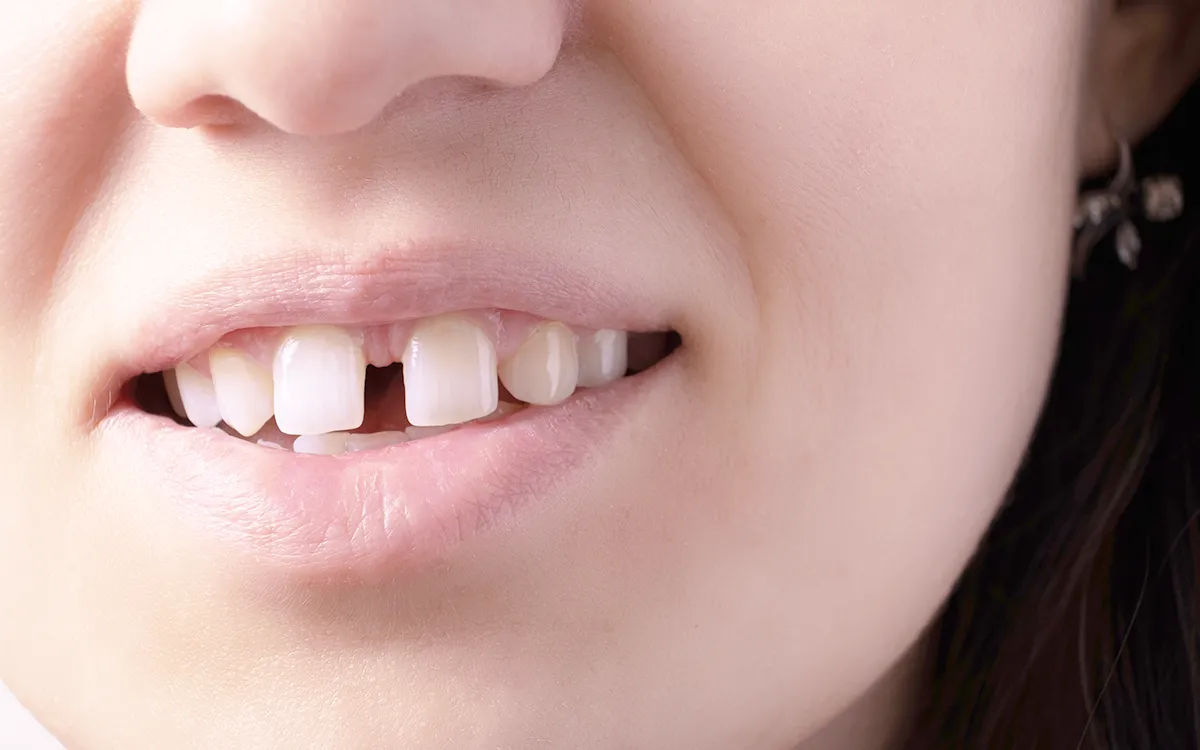A gap between your teeth can be a distinctive part of your smile. For some, it’s a unique feature to embrace; for others, it may be something they’re considering treating. Either way, it’s important to understand that a tooth gap isn’t just a cosmetic detail—it can have real implications for your oral health.
Food particles can easily get trapped in the space, making it harder to keep clean. Over time, this can lead to plaque buildup, gum irritation, or even cause nearby teeth to shift, affecting your bite and overall dental function.
So how do you keep your smile in top shape when there’s a gap in the lineup? Whether you’re proudly sporting your natural spacing or planning for future treatment, here’s what you need to know to maintain excellent oral health—gap and all.
What’s behind the gap?
Tooth gaps—also known as diastemas—can occur for a variety of reasons. Some are completely natural, while others may result from dental conditions or habits over time. Understanding the cause of your gap is the first step toward protecting your oral health and deciding whether treatment is necessary.

Sometimes, tooth gaps simply run in the family. A common genetic cause is a mismatch between the size of the teeth and the size of the jaw—if your teeth are relatively small for your jaw, gaps can naturally occur.
When a tooth is lost—whether from injury, decay, or extraction—and not replaced, the surrounding teeth can slowly drift into the empty space. This shifting can cause gaps to form elsewhere in your bite as well.
Certain habits during childhood, such as thumb sucking, lip biting, or tongue thrusting (pushing the tongue against the teeth when swallowing), can place repeated pressure on the front teeth, gradually pushing them apart.
The labial frenulum is the small piece of tissue that connects the inside of your upper lip to your gums. If this tissue is unusually thick or extends too far down between the front teeth, it can physically prevent them from closing together.
Advanced gum disease doesn’t just affect your gums—it can damage the underlying bone structure that supports your teeth. As the bone weakens, teeth can loosen and shift, leading to the development or widening of gaps.
Identifying the reason behind your tooth gap isn’t just about appearance—it can provide essential insight into your overall dental health. With your dentist’s guidance, you can take the right steps to protect your smile and maintain proper alignment and function.
Why is excellent oral hygiene essential?
A gap in your smile might add character, but it also creates extra responsibility. Those open spaces can act like magnets for food particles and plaque, setting the stage for gum irritation, decay, or even bad breath if not properly managed. That’s why a meticulous oral hygiene routine is non-negotiable when it comes to keeping your smile healthy.
Brush thoroughly—but gently: Use a soft-bristled toothbrush and fluoride toothpaste to brush at least twice daily. Pay extra attention to the area around the gap—especially along the gumline—where plaque and food tend to accumulate. Gentle, circular motions are best to avoid irritating the gums or causing enamel wear.
Floss like you mean it: Even with a noticeable space, flossing remains essential. It clears out plaque and debris from between teeth and under the gumline—areas your toothbrush simply can’t reach. For wider gaps, try using interdental brushes or soft picks, which can clean more effectively without damaging your gums.
Upgrade your tools: Consider adding a water flosser to your routine, especially if food frequently gets trapped in the gap. These devices flush out debris with a gentle stream of water, offering a deeper clean. An electric toothbrush with a built-in pressure sensor can also help you clean more thoroughly without brushing too hard.
Eat smart to protect the space
Some foods are more likely to get stuck and lead to plaque formation or discomfort when you have a gap. While you don’t have to avoid them completely, it pays to be cautious.

- Sticky or chewy foods (toffees, dried fruits)
- Stringy meats (steak, chicken)
- Hard or sharp snacks (popcorn, nuts)
- Crunchy fruits and vegetables like apples, celery, and carrots help clean your teeth as you eat.
- Calcium-rich foods like dairy and leafy greens support strong enamel.
- Plenty of water to rinse your mouth and reduce bacterial buildup.
Dental checkups: Your best ally in prevention
Even the most diligent brushing and flossing routine has its limits, especially if you have a tooth gap. That’s where professional dental care steps in. Regular checkups aren’t just about cleaning your teeth; they’re your front line of defence against issues that may be silently developing beneath the surface.
- Plaque turns into tartar—and only your dentist can remove it.
- Early signs of gum disease or tooth movement are often painless but easy for a dentist to spot.
- Bite changes caused by shifting teeth can lead to jaw strain, sensitivity, and headaches.
For most people, a dental checkup and professional cleaning every six months is recommended. If you’re prone to plaque buildup, have a history of gum issues, or notice changes around your gap, your dentist may suggest more frequent visits.
Is treatment necessary? Sometimes, yes
Not every tooth gap demands correction—many are harmless, and some people choose to embrace the unique character it adds to their smile. But in other cases, leaving a gap unaddressed can create more than just cosmetic concerns. Gaps that disrupt function, hygiene, or comfort may benefit from professional treatment.
Functional reasons to consider treatment

Frequent food trapping: If food consistently gets lodged in the space, it can lead to increased plaque buildup, tooth decay, and gum irritation, no matter how well you brush and floss
Shifting or missing teeth: A gap caused by tooth loss or movement can throw off your entire dental alignment. Over time, this can affect how your upper and lower teeth meet, potentially leading to further spacing, crowding, or misalignment.
Bite problems and jaw discomfort: Gaps that alter your bite can lead to uneven wear on your teeth and place extra pressure on your jaw joints. This can cause discomfort, muscle tension, or even chronic jaw pain (TMJ disorders).
Speech difficulties: In some cases, especially with larger front-tooth gaps, airflow through the space can lead to speech issues, such as lisps or difficulty articulating certain sounds.
Common treatment options
- Orthodontics: Braces or clear aligners (like Invisalign) can gradually move teeth into a more optimal position.
- Bonding or veneers: For minor gaps, tooth-colored composite or custom veneers can fill the space aesthetically and functionally.
- Dental implants or bridges: For gaps caused by missing teeth, these provide a long-term, stable solution that restores both appearance and function.
Long-term tips for a healthy, gappy smile
Whether you’re rocking your natural gap or waiting for orthodontic trays to do their magic, here’s how to keep your smile in peak condition:
1. Don’t ignore signs of gum irritation, shifting teeth, or bad breath.
2. Use tools that work for your specific gap size—don’t assume one floss fits all.
3. Ask your dentist about sealants or fluoride treatments to protect vulnerable areas.
4. Stay consistent with appointments—prevention is always easier than repair.
A healthy smile is a confident smile
A tooth gap is nothing to hide—it’s simply one of the many natural variations that make each smile unique. But as with any distinct dental feature, it can require a bit of extra care to keep everything in balance. The great news? With a solid oral hygiene routine, routine dental checkups, and smart, informed decisions about treatment, you can enjoy excellent oral health and a smile that feels as good as it looks.
If your gap ever begins to bother you—whether for comfort, function, or appearance—it’s worth having a conversation with your dentist. They can help you understand what’s happening and guide you through your options, no pressure involved.
So the next time you catch your reflection, don’t focus on the space—focus on the strength of the smile around it. Because confidence doesn’t come from perfection; it comes from taking care of what’s yours.




